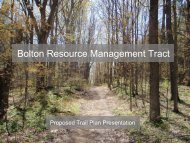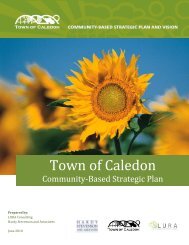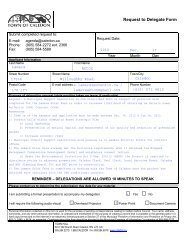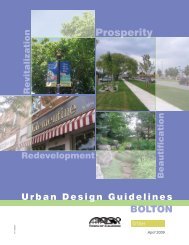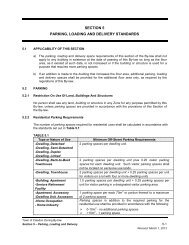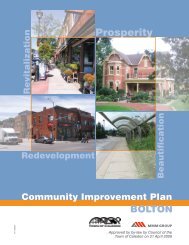Alton Village Study Draft Phase 1 Background ... - Town of Caledon
Alton Village Study Draft Phase 1 Background ... - Town of Caledon
Alton Village Study Draft Phase 1 Background ... - Town of Caledon
Create successful ePaper yourself
Turn your PDF publications into a flip-book with our unique Google optimized e-Paper software.
2.1.4 Planning Act Reform<br />
Various Planning Act amendments have taken place in recent years that could influence the<br />
<strong>Alton</strong> <strong>Village</strong> <strong>Study</strong>. The Strong Communities Act (Bill 26) was given Royal Assent on<br />
November 30, 2004. The legislation introduced longer appeal periods and removed the right <strong>of</strong><br />
appeal to the OMB for applications to expand settlement areas that are not supported by the<br />
municipality. This provision is retroactive to December 15, 2003. Planning decisions have to<br />
be consistent with policy statements issued by the Minister. Bill 51amendments to the<br />
Planning Act and consequential amendments to other Acts received Royal Assent on October<br />
19, 2006. It expanded a list <strong>of</strong> provincial interests to include the promotion <strong>of</strong> development<br />
that is sustainable, supports public transit and is pedestrian oriented. Approval authorities and<br />
the OMB have to have regard for the planning decisions made by municipal Councils.<br />
Planning decisions must be consistent with and conform with provincial policy statements and<br />
plans at the time <strong>of</strong> Council decisions. Enhanced public notice provisions and expanded scope<br />
<strong>of</strong> community improvement plan and clarification <strong>of</strong> municipal powers to regulate minimum<br />
and maximum heights and densities were among other changes to legislation.<br />
The key implication for the <strong>Alton</strong> <strong>Village</strong> <strong>Study</strong> is conformity with Provincial plans including<br />
the Greenbelt Plan and Places to Grow as well as consistency with the PPS. This will provide<br />
a basis against which scenarios may be evaluated.<br />
2.1.5 Environmental Assessment Act<br />
Ontario’s Environmental Assessment Act (EA Act) was passed in 1975 and proclaimed in<br />
1976. The EA Act requires proponents to examine and document the environmental effects<br />
that might result from major projects or activities and their alternatives. Municipal<br />
undertakings became subject to the Act in 1981.<br />
The EA Act sets a framework for a systematic, rational and replicable environmental planning<br />
process that is based on five key principles, as follows:<br />
1. Consultation with affected parties.<br />
2. Consideration <strong>of</strong> a reasonable range <strong>of</strong> alternatives.<br />
3. Identification and consideration <strong>of</strong> the effects <strong>of</strong> each alternative on all aspects <strong>of</strong> the<br />
environment.<br />
4. Systematic evaluation <strong>of</strong> alternatives in terms <strong>of</strong> their advantages and disadvantages<br />
to determine their net environmental effects.<br />
5. Provision <strong>of</strong> clear and complete documentation <strong>of</strong> the planning process followed, to<br />
allow “traceability” <strong>of</strong> decision-making with respect to the project.<br />
- 18 -




